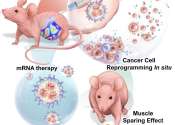Researchers develop messenger RNA therapy for ovarian cancer, muscle wasting
Researchers at Oregon State University and Oregon Health & Science University have developed a promising, first-of-its-kind messenger RNA therapy for ovarian cancer as well as cachexia, a muscle-wasting condition associated ...







